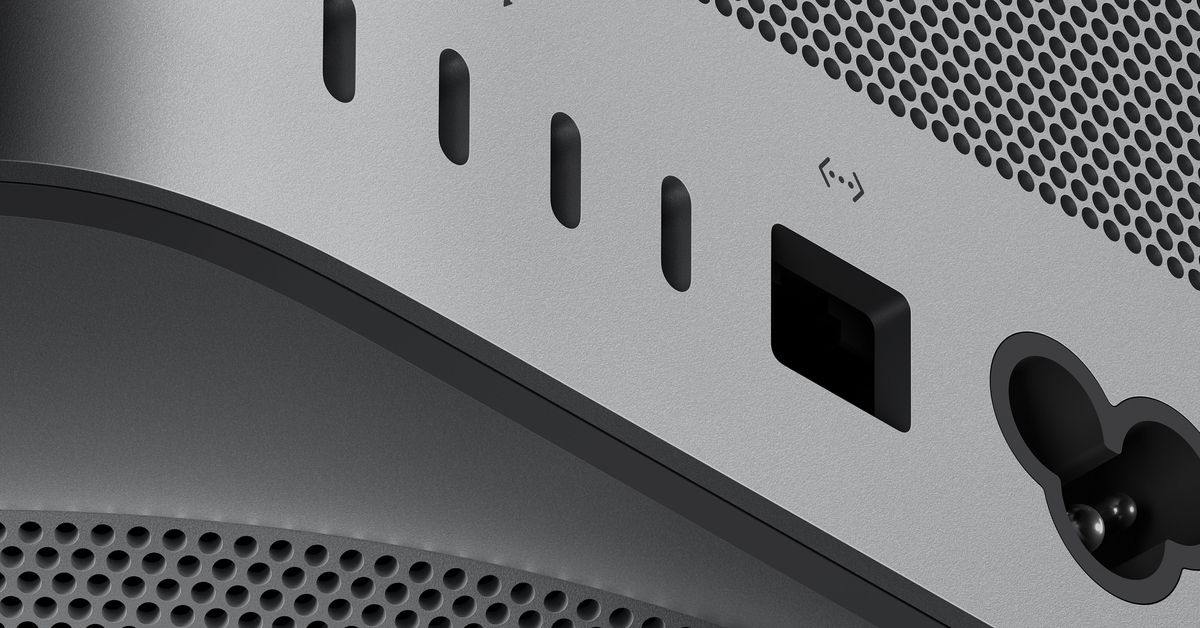Ford F-150 Lightning review: fast truck, slow computer
Photo by Vjeran Pavic / The VergeBluecruising into the future Continue reading…

Bluecruising into the future
The new electric F-150 Lightning is a big deal for Ford and, really, for the car industry at large. The F-150 has been the bestselling vehicle in America for over 40 years now, which means an EV F-150 is a big step toward electrifying cars, period.
But it’s mainly a big step for Ford, which is rapidly undergoing a massive transformation into an electric car maker. Ford CEO Jim Farley recently restructured the company into two divisions: Ford Blue, which will focus on gas-powered cars, and Ford Model E, which will be led by ex-Apple and Tesla exec Doug Field and develop EVs and software. Farley is cutting jobs from the gas division and investing in the EV division; it’s no secret where he thinks the future lies.
But there are a lot of steps from here to there, and Ford still has to handle some of the basics, like expanding the charging network for the Lightning and Mustang Mach-E so it can compete with the Tesla Supercharger network. It’s also completely resetting its software strategy in a partnership with Google, with a big transition to Android Automotive and Google services coming in the future. And, of course, there’s the little problem of convincing American truck buyers that an electric F-150 is still… an F-150.
Happily, the F-150 Lightning is a terrific F-150 — and a terrific truck. If you can find one to buy for a reasonable price and you’ve got a handle on charging for how you’ll use it, it’s clearly a better choice than a gas-powered truck.
But the Lightning is not without its issues — Ford can’t make enough to meet demand, just raised prices, and is still trying to get dealers to stop marking available units up by tens of thousands of dollars. And then there’s the software. This is a very fast truck that is also a maddeningly slow computer.
:no_upscale()/cdn.vox-cdn.com/uploads/chorus_asset/file/23916928/vpavic_220621_5352_0110.jpg) The Lightning display can automatically switch between dark and light mode, which is nice.Photo by Vjeran Pavic / The Verge
The Lightning display can automatically switch between dark and light mode, which is nice.Photo by Vjeran Pavic / The Verge
I talk to a lot of car CEOs on the Decoder podcast, and there’s a big idea that comes up consistently in all of those conversations: the notion that cars are becoming smartphones on wheels. Ford’s Farley was explicit about it in his last Decoder appearance, saying that his goal was “a fully networked vehicle… like you said, a computer on wheels.”
Reviewing the Lightning like a computer on wheels makes it clear that while there might be a lot of code in modern cars, there still isn’t a lot of thought about what makes a great user experience for a rolling computer. The Lightning is in some ways a dazzling technical achievement — a reliable mass-produced EV pickup truck that claims 300 miles of range and acceleration that let me keep up with a new Corvette Stingray in an impromptu highway showdown — but also a stopgap as Ford resets its entire software strategy around Android in partnership with Google.
That new Android-based software isn’t shipping on any Ford vehicles until sometime next year, though, and probably not on this generation of F-150s at all. That means, for now, we’re looking at Ford Sync, which, well, it’s Ford Sync. Regular F-150s have a 12-inch landscape center screen running Ford Sync 4; the Mustang Mach-E and the Lightning have a 15.5-inch portrait center screen running Sync 4A, which is the same as Sync 4 with the addition of touchscreen climate controls and widgets that fill out the vertical height of the display.
The result is that the software experience of the Lightning often feels trapped in the past, with no clear path to the future because Ford’s real software efforts lie elsewhere. The instrument cluster features the same cryptic icons and fundamental menu layout Ford has used in its cars forever. That huge portrait infotainment screen is woefully underutilized and the menu layout can feel like a randomly generated maze with no destination. (I’m serious: the top two menu panels are labeled “Controls” and “Settings” but then the screens for individual tabs under “Controls” have buttons labeled “Settings,” as though Ford’s designers all attended a seminar about the relative and evolving nature of all language.)
The screen is laid out into four zones: there’s a menu bar area; what you might call the app window; those widgets; and then the climate controls. Once you start using Sync 4A in the Lightning, you quickly encounter two main issues: one, the whole thing can feel extremely slow; and two, the screen is wildly underused compared to how big it is. You can do one thing at a time on the 15.5-inch screen, and that’s really it. There are oceans of pixels here, but for some reason, you can’t have the map and the radio open at the same time.
:no_upscale()/cdn.vox-cdn.com/uploads/chorus_asset/file/23763414/npatel_220626_5328_0019.jpg) If anyone wants to write a story about how blue replaced green as the symbolic EV color, hit me up.Photo by Nilay Patel /The Verge
If anyone wants to write a story about how blue replaced green as the symbolic EV color, hit me up.Photo by Nilay Patel /The Verge
There’s a quick action button to navigate back home on the map widget, but it just opens the map app full-screen, defeating the purpose of the widget entirely. I’d love to have CarPlay open to handle my phone and messaging alongside the radio, but that’s not possible, even though the display is clearly big enough to show both at once.
All of that is made worse by how slow everything is. Switching between the radio and the map or the map and CarPlay is… slow. Swiping along the cards is pretty slow. The display can be responsive, and the games are certainly playable, but in most instances, it’s just slow.
This is the point in any car review where many people are already drafting emails to me about just using CarPlay or Android Auto instead of the stock software, but friends, CarPlay and Android Auto are not good at helping EV owners navigate charging. If you want to plot out a route with accurate range estimates and an effective charging strategy, you have to use the built-in nav — especially since Ford has taken the time to organize charging stations by speed, and seeking out 150kW fast chargers is an important part of the Lightning experience because the battery is so big. Apple and Google are a long way behind on this front.
All of this slowness isn’t so far outside of the realm of car software experiences that it’s a deal-breaker, but Ford’s insistence on using touchscreen climate controls in the Lightning is a real miss. First of all, there are no good touchscreen climate controls on any car; buttons are always better. Second, Ford’s own gas-powered F-150s have physical buttons below the screen for the climate controls, as does the base XLT Lightning and the fleet-oriented Lightning Pro work truck. The problem was already solved, but Ford has taken good and fast buttons and replaced them with a slow and distracting touch interface that is fancy for the sake of being fancy.
Switching on the seat heaters requires multiple taps and swipes. There’s a slider control to change the fan speed. Changing which vents are active opens a detailed render of the truck’s interior, which is not all that useful. Other F-150s let you adjust all of these things with hard buttons, which are vastly simpler to use.
:no_upscale()/cdn.vox-cdn.com/uploads/chorus_asset/file/23916916/vpavic_220621_5352_0016.jpg) Touchscreen climate controls are bad.Photo by Vjeran Pavic / The Verge
Touchscreen climate controls are bad.Photo by Vjeran Pavic / The Verge
It’s the same with the various cameras. My own late model F-150 has a hard button above the screen to open the cameras, which I use all of the time to park in tight spots and generally navigate the thing, but on the Lightning, opening the cameras takes a few taps on the screen. And once you have the cameras open, the menu to switch between them keeps closing itself for some reason, even though there’s plenty of room on the display to just stay open all the time.
I can keep going. The menu bar at the top of the infotainment screen is littered with unlabeled status icons, like an unloved Android phone. Placing your phone on the wireless charger causes a phone icon to appear in the menubar without any clear indication of what it represents. And using the excellent driver-assistance systems is an exercise in figuring out information the truck doesn’t seem interested in telling you.
Ford’s entire suite of driver-assistance tech is called “BlueCruise,” which is deeply confusing because it means that everything from boring old cruise control to full-on hands-free driving is technically “BlueCruise.” When you turn on adaptive cruise control with active lane assist and it feels like the truck is driving down the highway in hands-free mode, that’s BlueCruise, even though it unhappily beeps at you if you take your hands off the wheel for more than a few seconds. Full hands-free driving is only available on major highways mapped by Ford; the map is fairly comprehensive at this point.
But because it’s all called “BlueCruise,” nothing in the Lightning tells you which specific capabilities are actually available at any particular moment; it just says “BlueCruise.” To figure it out, you just have to switch on the cruise control and see if the little “hands-free” icon appears. I had to email Ford to clarify all of these various modes; nothing on the vast 12-inch instrument cluster or the center screen really made any of them clear.
All that said, the hands-free driving system works great when it’s available. I used it for two 300-mile road trips, and the system is confident and steady and generally made me want to get a Lightning immediately.
Look, some of this makes sense — changing how an iconic vehicle works is tough to do, and the new computer simulating parts of the old system to ease generations of F-150 owners into the future is a safe path. But most of it feels like Ford didn’t know what to do with the massive amount of screen real estate in the Lightning, so it chose not to do very much at all.
:no_upscale()/cdn.vox-cdn.com/uploads/chorus_asset/file/23763417/npatel_220626_5328_0037.jpg) Yes, I drove a $96,000 review unit to the dump.Photo by Nilay Patel /The Verge
Yes, I drove a $96,000 review unit to the dump.Photo by Nilay Patel /The Verge
Annoyances with the software aside, the Lightning is otherwise a terrific EV and a great truck. I did a bunch of truck stuff with it, including hauling our trash to the dump, and it handled it all with aplomb. In day-to-day use, it acts just like a regular F-150, which is great.
But press the pedal down, and it moves. This is one of the fastest production trucks ever made: the official zero to 60mph time is 4.3 seconds and Car and Driver tested it at just 4. That’s faster than my F-150 Raptor and enough to beat the ridiculous 700-horsepower Ram TRX in some tests. The only consistently faster truck is the Rivian R1T, which can go from zero to 60mph in 3 seconds.
My Raptor is a big truck that can go fast, but the Lightning is something else. It has that instant, smooth EV torque no matter how fast you’re going with none of the downshifts or drama of a gas truck. Driving a regular EV is a fun change from regular cars, but driving the Lightning is a huge change from other trucks: things this big don’t usually move this quickly, and the big battery and lower center of gravity combined with the independent rear suspension keep it planted even over rough bumps that make the rear end of my truck bounce all over the place. It has to be one of the easiest full-size pickups in the world to drive, and you can smoke anyone short of expensive sports cars and other fast EVs basically whenever you want. I love it.
:no_upscale()/cdn.vox-cdn.com/uploads/chorus_asset/file/23763420/npatel_220626_5328_0049.jpg) Plug-and-charge worked great at Electrify America stations.Photo by Nilay Patel /The Verge
Plug-and-charge worked great at Electrify America stations.Photo by Nilay Patel /The Verge
Of course, gunning the Lightning all over town eats up range, and that means you have to deal with charging, both at home and out in the wild. You absolutely need a Level 2 charger at home with the Lightning since the battery is huge and trying to charge it with a standard 110 outlet netted less than one mile of range per hour, which might as well be nothing.
Extended-range Lightnings like our review unit come with Ford’s 80-amp Charge Station Pro, which requires professional installation and allows the Lightning to serve as a backup power source for your home in case of a blackout, but since I only had the thing a week, I just plugged Ford’s 30-amp travel charger into my 240-volt dryer outlet and it charged just fine overnight, at around 15 miles of range an hour. Plugged into a 150kW DC fast charger, Ford says you can go from 15 to 80 percent in 41 minutes. The truck maxes out at 155kW, so hunting for the rare 350kW charger isn’t really worth it.
At 100 percent charge, the Lightning reports its range at 325 miles, but that number quickly drops as you drive around, especially where I live in the mountains. You can plan trips in the FordPass mobile app and send them to the built-in nav, which will plot out chargers along your route. Those charging stops are locked in once you set a route; it would be nice if the system would give you more options along the way.
Charging on the road is mostly handled through Ford’s app and charging network; the company has been building out its network since the Mach-E came out last year, and things are improving but still occasionally spotty. You can sort available chargers by charging speed in the app and on the built-in nav. Chargers in the Ford network can be activated on your phone but not in the truck for some reason. Importantly, I had no problems using plug-and-charge at supported stations, which automatically activates a charger and handles billing just by plugging in. And, of course, you can just pay with a credit card if you want. And while I charged at several Electrify America stations that worked well, there were the usual broken chargers and glitches in getting things started. There’s still a long way to go, but things have started improving in meaningful ways since we reviewed the Mach-E.
:no_upscale()/cdn.vox-cdn.com/uploads/chorus_asset/file/23759777/npatel_220624_5328_0055.jpg) Having a huge frunk in a pickup truck is incredibly useful.Photo by Nilay Patel /The Verge
Having a huge frunk in a pickup truck is incredibly useful.Photo by Nilay Patel /The Verge
One of the big advantages and disadvantages for Ford is that it already makes and sells a lot of F-150s, and it can keep the costs of Lightning down by using a lot of F-150 parts in it. Ford doesn’t have to reinvent the wheel: the Lightning uses the F-150 steering wheel. The seats are just the F-150 seats. The wipers have already been designed.
All that part reuse means Ford can theoretically keep the costs of the Lightning down since it’s already scaled production way up. But batteries are still hard to source, and the company just reopened orders with newly raised prices to account for the supply issues. The base Lightning Pro that’s designed to be a work truck now starts at $46,974. The XLT trim, which is the base consumer model, starts at $59,474. Our review unit is a top-of-the-line Platinum, which has every luxury option you can think of and a sticker price of $96,874, which is $20,000 more than a similarly optioned gas F-150 Platinum. Those are Ford’s prices, though; dealers have been marking Lightnings way up to $150,000 and more.
That’s actually the biggest problem with the Lightning: it’s more or less impossible to buy. While some customers are starting to get their early preorders and Ford is ramping up production as fast as it can, Farley told me that the company won’t be able to build enough Lightnings to fill all of the preorders, let alone meet demand. The goal is to build 150,000 Lightnings a year, but right now, there just aren’t enough batteries to get there. Ford is investing in battery plants, expanding the Lightning factory, and hiring more people, but it’s all just going to take time.
Until then, either you’re stuck waiting on the preorder list until next year or you’re fighting it out with dealers. Ford’s trying to get all of those dealers back in line, but there’s a lot of history there and a lot of challenges along the way. But if the Lightning is going to actually be as important of an EV as it should be, Ford’s got to figure all of that out.
:no_upscale()/cdn.vox-cdn.com/uploads/chorus_asset/file/23916913/vpavic_220621_5352_0004.jpg) My Raptor looks meaner, but the Lightning can leave it in the dust.Photo by Vjeran Pavic / The Verge
My Raptor looks meaner, but the Lightning can leave it in the dust.Photo by Vjeran Pavic / The Verge
In the end, there’s two ways to look at the Lightning. First, it’s a terrific electric F-150 that will ease a lot of truck owners into an EV. And in that way, it’s a huge success. If I could actually find one to buy for a reasonable price, I’d trade in my gas-powered F-150, issues with the software aside. (I would plan to immediately trade it in again once the version with Android-based Sync comes out, though.)
But that software points to Ford’s bigger challenge, which is that the Lightning sometimes feels caught between two worlds. Right now, it’s very much a truck with a slow tablet in it. Letting this thing really be a computer on wheels would take the Lightning from really good to historically great.

 Konoly
Konoly 
































